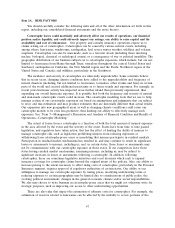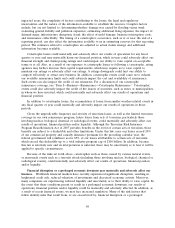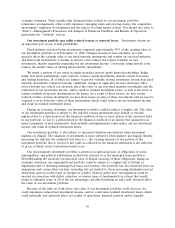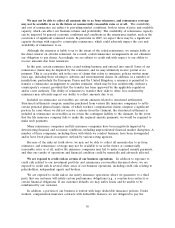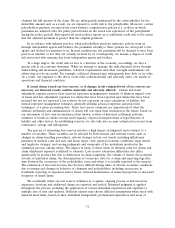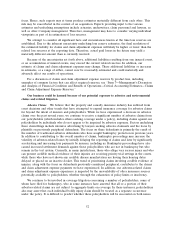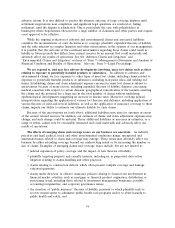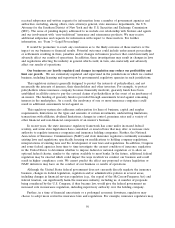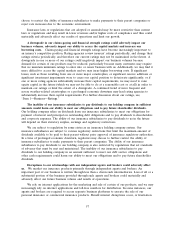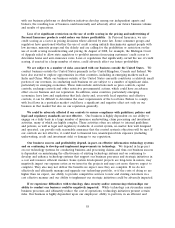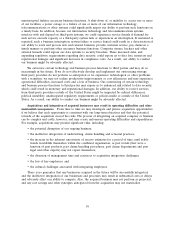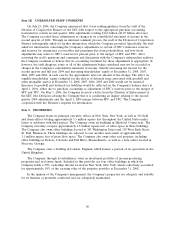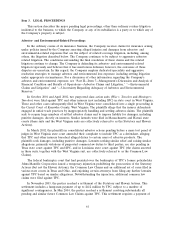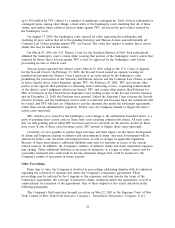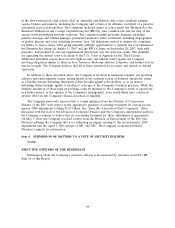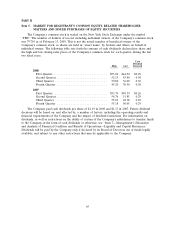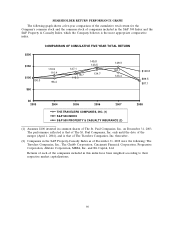Travelers 2008 Annual Report Download - page 68
Download and view the complete annual report
Please find page 68 of the 2008 Travelers annual report below. You can navigate through the pages in the report by either clicking on the pages listed below, or by using the keyword search tool below to find specific information within the annual report.received subpoenas and written requests for information from a number of government agencies and
authorities, including, among others, state attorneys general, state insurance departments, the U.S.
Attorney for the Southern District of New York and the U.S. Securities and Exchange Commission
(SEC). The areas of pending inquiry addressed to us include our relationship with brokers and agents
and our involvement with ‘‘non-traditional’’ insurance and reinsurance products. We may receive
additional subpoenas and requests for information with respect to these matters. For further
information, see ‘‘Item 3—Legal Proceedings’’.
It would be premature to reach any conclusions as to the likely outcome of these matters or the
impact on our business or financial results. Potential outcomes could include enforcement proceedings
or settlements resulting in fines, penalties and/or changes in business practices that could materially and
adversely affect our results of operations. In addition, these investigations may result in changes in laws
and regulations affecting the industry in general which could, in turn, also materially and adversely
affect our results of operations.
Our businesses are heavily regulated and changes in regulation may reduce our profitability and
limit our growth. We are extensively regulated and supervised in the jurisdictions in which we conduct
business, including licensing and supervision by governmental regulatory agencies in such jurisdictions.
This regulatory system is generally designed to protect the interests of policyholders, and not
necessarily the interests of insurers, their shareholders and other investors. For example, to protect
policyholders whose insurance company becomes financially insolvent, guaranty funds have been
established in all fifty states to pay the covered claims of policyholders in the event of an insolvency of
an insurer. The funding of guaranty funds is provided through assessments levied against remaining
insurers in the marketplace. As a result, the insolvency of one or more insurance companies could
result in additional assessments levied against us.
This regulatory system also addresses authorization for lines of business, capital and surplus
requirements, limitations on the types and amounts of certain investments, underwriting limitations,
transactions with affiliates, dividend limitations, changes in control, premium rates and a variety of
other financial and non-financial components of an insurer’s business.
In recent years, the state insurance regulatory framework has come under increased federal
scrutiny, and some state legislatures have considered or enacted laws that may alter or increase state
authority to regulate insurance companies and insurance holding companies. Further, the National
Association of Insurance Commissioners (NAIC) and state insurance regulators continually reexamine
existing laws and regulations, specifically focusing on modifications to holding company regulations,
interpretations of existing laws and the development of new laws and regulations. In addition, Congress
and some federal agencies from time to time investigate the current condition of insurance regulation
in the United States to determine whether to impose federal or national regulation or to allow an
optional federal charter, similar to the option available to most banks. In the future, additional federal
regulation may be enacted which could impact the ways in which we conduct our business and could
result in higher compliance costs. We cannot predict the effect any proposed or future legislation or
NAIC initiatives may have on the conduct of our business or results of operations.
Although the United States federal government does not currently directly regulate the insurance
business, changes in federal legislation, regulation and/or administrative policies in several areas,
including changes in financial services regulation (e.g., the repeal of the McCarran-Ferguson Act) and
federal taxation, can significantly harm the insurance industry, including us. A number of proposals
being considered by the U.S. Congress, if they became law, would give the federal government an
increased role in insurance regulation, including supervisory authority over the holding company.
Further, in a time of financial uncertainty or a prolonged economic downturn, regulators may
choose to adopt more restrictive insurance laws and regulations. For example, insurance regulators may
56



